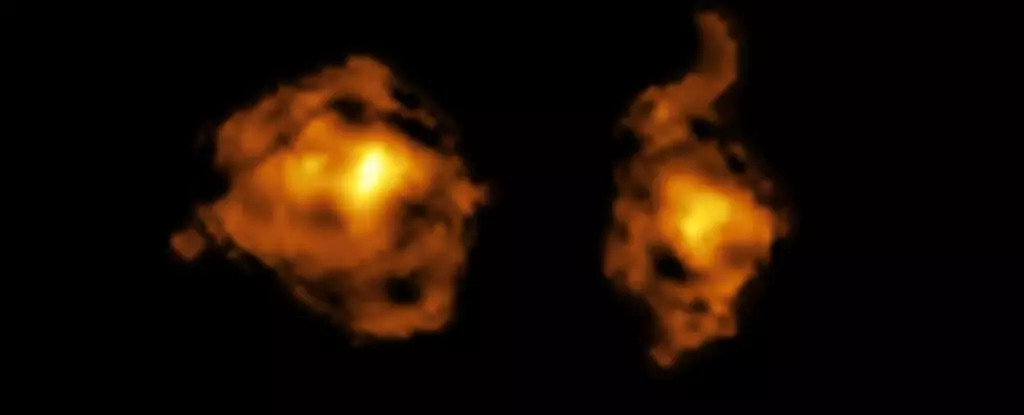In a remarkable discovery that stirs the imagination, astronomers have captured the dramatic interaction between two galaxies in the throes of a violent dance. The event—dubbed the ‘cosmic joust’—signals a significant advancement in our understanding of galactic interactions, particularly those influenced by supermassive black holes. This unprecedented observation showcases how one galaxy can unleash a torrent of radiation, effectively ‘wounding’ a neighboring galaxy during their collision. Here, we uncover the implications of this cosmic event and what it reveals about the environments in which galaxies evolve.
The Role of Quasars in Galactic Dynamics
At the heart of this discovery is the phenomenon of quasars, which are galaxies hosting supermassive black holes that are actively consuming material at incredibly high rates. This ravenous behavior leads to a situation where luminescent jets are expelled from the black hole’s poles at nearly the speed of light, creating powerful beams of radiation. In the cosmic joust, the quasar’s jets are not merely passive observers; they strike the ‘wounded’ galaxy with relentless intensity, disrupting the delicate balance of gas and dust integral to star formation.
What does this mean for the galaxy on the receiving end of the joust? The pressure of the quasar’s radiation appears to severely hinder the formation of new stars. As radiation blasts through, it strips away the very material needed for star formation, leaving behind a barren expanse where once there might have thrived a nursery for celestial bodies. This leads to an ironic twist in the life of galaxies—a quasar’s hunger results not only in its own growth but in the stunted development of a companion galaxy.
The Cosmic Tapestry: Dark Matter and Galactic Mergers
Galactic collisions are not isolated accidents within the void of space; they form part of a greater cosmic tapestry woven by dark matter. The universe is interlaced with an almost invisible web of dark matter, which acts as a gravitational glue, facilitating the congregation of galaxies into clusters. These clusters, characterized by their dynamic nature, often become arenas for spectacular sightings of galactic mergers.
The ongoing interaction of these massive systems also plays a crucial role in the evolutionary path of galaxies. As they draw closer, their gravitational attractions guide them into repeated encounters. Each pass reshapes their structure and fuels their growth. Yet, the consequences of such gravitational dances can be both constructive and destructive. On one hand, galactic mergers are essential catalysts for new star formation; on the other hand, as evidenced by the cosmic joust, a quasar’s reign can be anything but nurturing.
A Dual-Edged Sword: The Paradox of Quasar Activity
Understanding the dual nature of quasar activity raises vital questions about the lifecycle of galaxies. While they can promote galactic evolution, they also impose a heavy toll. As the quasar ferociously consumes its surroundings, it not only ejects jets that disrupt neighboring star-forming regions but also yields winds that clear out the host galaxy’s own resources. This process, aptly labeled quenching, is a reminder of the chaotic interplay in cosmic evolution—a cycle where one paradigm thrives at the expense of another.
Thus, we observe that the very forces that govern the birth of stars can also precipitate their demise. The cosmic joust exemplifies this tangled relationship, underscoring that creation and destruction are often two sides of the same coin in the universe’s grand design.
The Promise of New Beginnings Amidst Destruction
Interestingly, despite the apparent devastation, the cosmic joust carries a glimmer of hope amidst its turmoil. As galaxies collide and merge, the shockwaves produced can catalyze the formation of new stars. Overlapping gas reservoirs create conditions ripe for gravitational collapse, leading to the birth of new stellar bodies. In essence, what might seem like an end is often a precursor to new beginnings. The chaos that ensues from galactic interactions serves as fertile ground for the universe’s rejuvenation, aligning with the idea that from destruction springs new life.
Thus, within the cosmic joust lies an intricate dance of fate, where galaxies navigate the fraught paths of birth, evolution, and demise—crafting a narrative much more intricate and breathtaking than we ever envisioned. Every beam shot across the cosmos tells a part of the story that continues to unfold, revealing the ever-evolving interstellar relationships that shape our universe.

